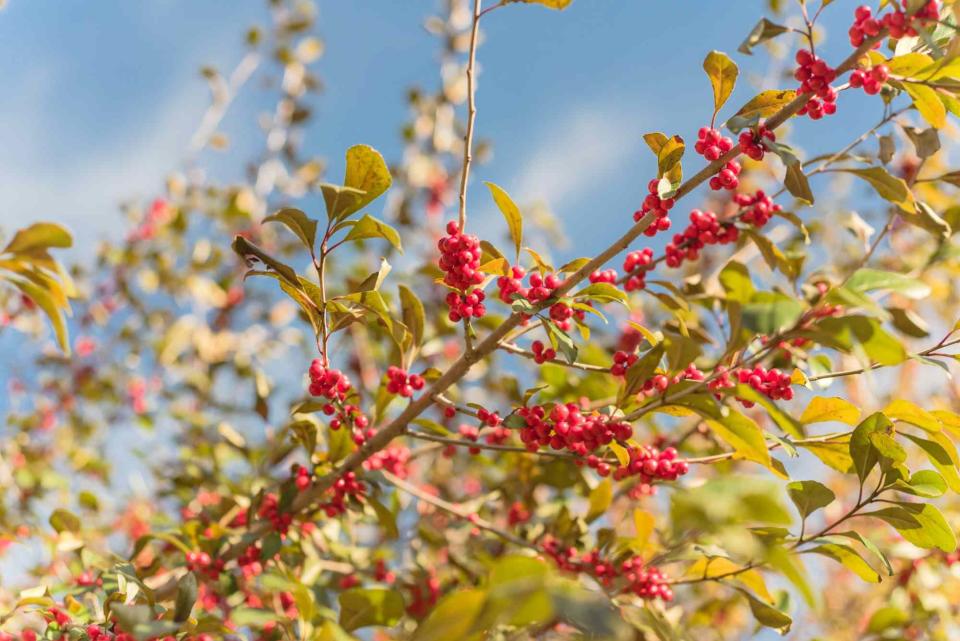5 Ways To Use Hollies In Your Landscape
Hollies serve myriad functions in the landscape, from specimen to screen, and can be used to provide structure and color all year long.

The name holly likely draws to mind the quintessential winter shrub, with thick evergreen foliage and bright red berries, but not all hollies fit this description. Hollies come in many shapes and sizes. Some have evergreen foliage while others are deciduous. Many species produce brilliant red berries while others are grown for foliage and structure. The largest species grow upwards of sixty feet tall and the smallest hug the ground. Such diversity allows hollies to play many different roles in the garden. Here are five ways to use hollies in the landscape to add texture, color, and structure.
Use Hollies for Screening and Backdrops
Larger holly varieties can be used to create a wall or hedge that serves as a privacy screen or backdrop to other plantings. The deep green foliage of hollies such as Robin™ Holly (Ilex hybrid 'Conin') provides a stage to display showy specimens or accent plants spring through fall, while dark red berries add color in winter. Hardy in zones 6-10, Robin™ Holly grows 15 to 20 feet tall by 12 to 15 feet wide.
In tighter spaces, the narrow and upright 'Will Fleming' Yaupon Holly (Ilex vomitoria) provides a compact screen growing a similar height, but only 2 to 3 ft. wide. Both varieties perform well in full to partial sun and adapt to a wide variety of soil conditions, provided soil is well-drained. When selecting a holly for screening, consider the extent of enclosure desired. Space plants closer for a denser screen and wider apart for a more open enclosure. 'Will Fleming' Yaupon Holly is hardy in zones 7-10.
Hollies Anchor a Planting
A well-designed planting unites the home with its surroundings. One way to ground your home is by using plant material that gradually steps down from the roof line to the ground plane. With its classic pyramidal form, Oakland™ Holly (Ilex hybrid 'Magland') makes a great anchor plant. Although the 15- to 20-foot height carries the eye skywards, the bulk of the plant is close to the ground, settling it firmly in the garden. Oakland™ Holly grows 8 to 12 feet wide and thrives in organically rich, slightly acidic, moist, well-drained soil in zones 6-9. Plants tolerate full sun but benefit from afternoon shade in the hot Southern sun.
Massing Hollies in the Landscape
Low-growing hollies work well in mass plantings. Varieties with solid-colored foliage work best for massing—save the variegated hollies for accents. One of the most attractive hollies for planting in masses beneath trees or as a low-growing backdrop is Little Goblin® Red Winterberry Holly (Ilex verticillate 'NCIV1'). This compact variety grows just 3 to 4 feet tall and wide and is loaded with large, red berries. A North American native, Winterberry Holly is widely adaptable to different soil types and tolerates wet soil. Plant in full to partial sun in zones 3-9.
Like many hollies, Winterberry Hollies have separate male and female plants. For fruit production on Little Goblin® Red, you will need to plant Little Goblin® Guy Winterberry Holly as a pollinator. One male plant can pollinate up to five female plants. The male plants disappear into mass plantings, or you can plant them up to fifty feet away from females.
Hollies Make Striking Specimens and Accents
These hollies love to show off. For a stunning focal point in the winter garden, look no further than Deciduous Holly (Ilex decidua), also called Possumhaw. The berries remain long after the leaves have fallen, allowing the bright red fruits to shine against smooth gray bark. Deciduous holly has separate male and female plants. The berry-producing female plants are preferred in the garden. Look for named cultivars such as 'Warren's Red' and 'Red Cascade' to ensure berry production. Wild male pollinators are typically sufficient to provide pollination. Deciduous Holly grows as a large shrub or small tree with a rounded crown reaching 8 to 15' tall. Plant in full to partial sun in zones 5-9.
Accentplantsadd special interest to the garden, often through flowers, but also by providing contrast in form, color, or size. Variegated hollies such as Gold Coast® English Holly (Ilex aquifolium 'Monvila') provide plenty of contrast and make an eye-catching accent. This slow-growing holly matures to 4 to 6 feet tall and wide. Provide a rich, well-draining soil and afternoon shade from the hot Southern sun.
Smaller pyramidal varieties also work well as accents, with the strong lines grabbing your attention. Growing just 10 feet tall by 6 feet wide, Arrow Point™ Holly (Ilex hybrid 'RUTHO14') provides a powerful vertical element in small gardens without taking up limited real estate. It can also be used to mark transitions, such as from one garden room to the next. Both these hollies are hardy in zones 6-9.
Hollies for Edging
It's time to rethink the boxwood border. For a native alternative try Strongbox® Inkberry Holly (Ilex glabra 'ILEXFARROWTRACEY'). This compact evergreen works well in containers and mixed borders, or as an edging plant. Strongbox® Inkberry Holly can be pruned and shaped, but why bother—the natural mounded form looks great on its own and reaches just 2-3 feet tall and wide. Plant in full to partial sun in zones 5-9. Plants tolerate a variety of soils, including clay and wet conditions and the foliage is resistant to winter burn.For a brilliant golden border with burn-resistant foliage, try Brass Buckle® Japanese holly (Ilex crenata 'ANNYS1'). This diminutive holly grows just 18 inches tall and wide, forming a glowing yellow mound perfect for edging or tucking among perennials as a colorful accent. Plant in full to partial sun in average, well-drained soils in zones 6-8.
For more Southern Living news, make sure to sign up for our newsletter!
Read the original article on Southern Living.

